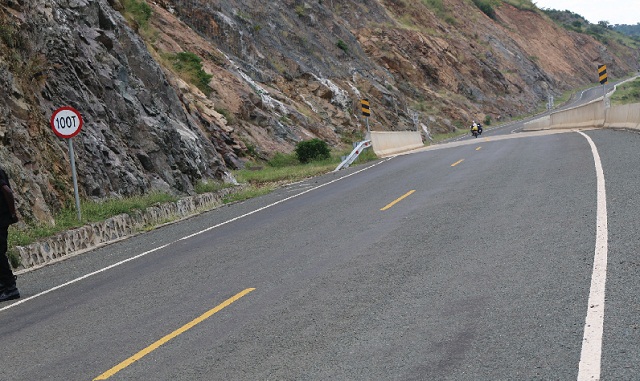Other sourced materials will move through on the southern corridor from Tanzania to Mutukula onto Masaka via Ssembabule, onto Lusalira, Nkonge-Mubende, Kakumiro, Nabyeyo-Buhimba-Hoima and from Hoima towards Buliisa. These will use the already available infrastructure up to Mutukula. The trucks, which will be heavy and carrying uneven materials, will avoid busy city centres.
Time is literally money. Unless Kagina does her work right and on time, the oil trucks might be caught up in the same mess as we found ourselves in – sitting for days on a narrow slippery earth road blocked by a non-roadworthy truck.
Kagina’s task is massive; considering that a sizeable stretch of these roads goes through both delicate and treacherous terrain, part of which is the western arm of the Great East African Rift Valley with sharp climbs and steep slopes. Kagina says initially she was afraid the roads would not be ready. But she now has a plan that can actually deliver the roads in two years’ time.
When she spoke to journalists on the tour on Nov. 29, she appeared unfazed and optimistic.
“Some of these challenges seem insurmountable,” she said, “but we have been here before.”
Kagina’s team on the tour included Michael Ochola, the team leader, Bridges and Structures who is also a member of the Oil Roads Studies taskforce; Davis Muhwezi, UNRA’s team leader, Transport Economics and Road Safety; William Matovu, UNRA’s Head of Land Acquisition, and Rachael Ngonzebwa, UNRA’s Western Regional Manager and the UNRA media team.

From the time we set off from the UNRA offices in Kampala, headed northwest for Hoima town—200km away, to the time we returned; we travelled over 700kms in two days.
On day one, our first stop was in Hoima town, where we had breakfast at 9.30am after a three-hour drive from Kampala. We had set off at 6.30am. We then hit the 130km Hoima-Butiaba-Bugungu road through Wanseko to Buliisa.
Part of this route goes through a treacherous-looking escarpment which at the moment looks narrow and has only patches of tarmac laid decades ago. From Buliisa we hit another dusty-road stretch of 30km of the Bugungu –Para road.
This section goes through the ecologically sensitive Murchison Falls National Park. From Para, we headed to Masindi via Park Junction, a distance of 90km and from Masindi; we got back to Hoima town via Biiso, another stretch of 100km. That is 550kms in one day. Not bad.
Along these routes, our convoy kept stopping for Kagina and her team to explain what we are supposed to note. Mainly it is sections that need urgent attention— a sharp escarpment that must be chiseled through, a narrow section that must be widened, long stretches that require resurfacing. Some points, like Buliisa town, require special attention. This is the hub of Total Oil’s operations and the roads here are a priority, noted Davis Muhwezi.
Day two is when we got stuck. But before that we had started with driving southward from Hoima for about 300km to inspect the Hoima—Kabwoya-Buhuka and the Kaseeta-Lwera-Kabaale-Kiziranfumbi-Hoima road and the Kingfisher oil field of CNOOC. There is very little activity at the oilfield, except thin staff on the ground; men in workshops doing maintenance work. But it is the 10km stretch of road that the Chinese constructed a couple of years ago, after cutting through the escarpment that leaves journalists impressed.
From here, we head to Kabaale, the area which will host the oil refinery, the international airport, and other critical oil infrastructure. We use the Kiziranfumbi road before proceeding to Hoima. At Kabaale, barring the signpost showing that an international airport will be built, the area remains bushy, 24 months to first oil.
We are supposed to see a section in central Uganda of about 200km on the Hoima-Buhimba-Kakumiro road before continuing to Mubende enroute to Kampala but, we are told, the road which is already under construction is not passable. So we end our trip in Hoima with our last briefing.
Kagina says besides showing the Ugandan public through the media the challenges that UNRA deals with every day, she wanted to allay fears that the critical oil roads may not be ready in two years’ time. She wants the public to know that the challenges UNRA faces on a daily basis are real.
UNRA’s Plan B
She also wanted to explain that UNRA might not do this project in the conventional way. Usually, she said, UNRA would require a year to procure a designer (consultant) for the project and another year to get a contractor. The consultant would need about a year to complete a detailed study for a 100km road.
Kagina said 600km is very many kilometers to do within two years but the roads agency has come up with “priorities within priorities” to make sure that these roads are motorable in two years’ time. Tarmac is no longer a priority; motorability is.
She said UNRA decided to concentrate first on the bottleneck areas which include at least four narrow bridges, sharp bends, swamps and the escarpment. Once the critical sections have been built and paved, the transporters should be able to deliver the materials to the region.
UNRA has done away with the conventional long-winding process and adopted a design and build contract approach. This means shorter procurement timelines and a contractor bearing all risks.
Ochola who heads the Taskforce said due to the short project timelines, UNRA constituted teams for design, procurement, environmental and social impact safeguards, and the execution and in February, this year; UNRA quickly recruited 77 contract-based staff to execute the project.
Before we return to Kampala, I ask Kagina what the main reason for the grueling tour of these dusty, bumpy roads was to UNRA and to her.
“We wanted the public to see what the real challenges are on the ground,” she said, “It is good to see the before and after.”
“I promise to bring you back in three years’ time (if I am still around) and you will drive on tarmac,” Kagina said.
The oil roads the government promised in 2016.
- Hoima-Butiaba-Wanseko road (111km),
- Masindi-Biiso (54km)
- Masindi-Bugungu via Murchison Falls National Park (80km)
- Kaseeta – Lwera via Bugoma Forest (16km)
- Hohwa-Nyairongo-Kyarushesha road (25km)
- Wanseko-Bugungu (23km)
- Lusalira-Nkonge-Sembabule (97km)
- Kyotera–Rakai (20km)
- Buhimba-Nalweyo-Kakindu-Kakumiro-Mubende (100km)
- Kabaale –Kiziramfumbi road (30km).
 The Independent Uganda: You get the Truth we Pay the Price
The Independent Uganda: You get the Truth we Pay the Price



Let it be constructed as the ugandans get jobs
Can the independent help us access how many years UNRA has been under this new management and how many Kilometers of road have been constructed during this period. This will help us understand the rate at which this team constructs roads and give a fairer indication of whether 600 km in 2years is a big ask or not.
it is better that kagina also tasted it. Let unra speed up.